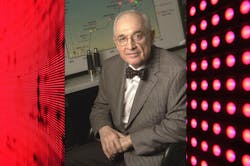Queen Elizabeth prize trumpets LEDs for harmonizing humans and nature
A prestigious British awards group that recognizes engineering innovations of global benefit to humankind has bestowed this year’s honors on five individuals for playing an indispensable role in establishing the LED as an everyday light source, and one “which will play a major role in ensuring that humanity can live in harmony with nature long into the future.”
The winners of the 2021 Queen Elizabeth Prize for Engineering includes professors Shuji Nakamura and Isamu Akasaki, who in 2014 both also shared the Nobel Prize for Physics for their work in developing blue diodes — a milestone that was key to making energy-efficient LEDs capable of providing white light and thus moving them into general illumination, beyond the world of indicator lights.
Nick Holonyak, credited for inventing the red LED at General Electric in 1962 — two or three decades before breakthroughs in blue — also shares this year’s £1 million (US$1.4M) QEPrize. Holonyak’s work is regarded by many to have been as instrumental as the Nobel-winning work of Nakamura, Akasaki, and a third scientist, Hiroshi Amano, in ultimately establishing the LED for general illumination. Nobel judges have yet to award him a medal, which some observers consider to be a slight.
Along the way in his career Holonyak, now 92 years old, served as a PhD advisor at the University of Illinois to the other two 2021 QEPrize recipients: George Craford, who developed the yellow LED at Monsanto Chemical Company in 1972, and Russell Dupuis, credited with advancing a metalorganic chemical vapor deposition process that paved the way for large-scale commercial production.
Dupuis is currently a professor of electrical and computer engineering at Georgia Institute of Technology and previously held a similar role at the University of Texas. His industry resumé includes stints at Texas Instruments, Rockwell International, and AT&T Bell Laboratories.
During today’s online awards presentation, Dupuis paid homage to his former mentor Holonyak.
”I recall when I was in high school that he had an interview in 1963 with the Readers Digest where he predicted white light from light-emitting diodes, which was a totally bizarre idea according to everyone else,” Dupuis said. “But Dr. Holonyak knew that it was the most efficient way to take electricity and make light. So he felt that the commercial applications were going to draw this technology forward into the market and become the universal light source.”
Holonyak was also effective at guiding young experts, if QEPrize co-winners Dupuis and Craford are an indication. Today is not the first time the three have been jointly recognized. In 2002, then-President George W. Bush awarded them a National Medal of Technology and Innovation.
The QEPrize for Engineering Foundation today granted the five individuals the prize “for the creation and development of solid-state lighting and its contribution to green energy,” said its chairman Lord John Browne of Madingley, former CEO of oil giant BP.
The foundation aspires to recognize engineering achievements as opposed to scientific accomplishments such as in physics or chemistry. That is why the third co-recipient of the 2014 Nobel for work in blue, Hiroshi Amano, was not among the QEPrize winners, lead judge Sir Christopher Snowden explained to LEDs Magazine.
The foundation heralded the benefits to humanity of the LED. Lord Browne emphasized the energy efficiency of solid-state lighting (SSL), and the tremendous advances of the technology compared to inefficient incandescent lighting that prevailed for a century.
“This year’s laureates have influenced the path of one of the most important innovations in human history,” Browne said in announcing the award. “This year’s prize winners have not only helped humanity to achieve a greater degree of mastery over the environment, they have enabled us to do so in a sustainable way. They’ve created a product which we now take for granted but which will play a major role in ensuring that humanity can live in harmony with nature long into the future.”
LEDs have also begun benefiting humankind in other ways as well.
“The remarkable thing to me is LEDs are now used to raise plants for food in confined spaces, in buildings with limited resources,” said Dupuis. “It’s probably going to be more important especially as we leave the Earth and go to Mars and beyond. There will be a need for growing fresh fruit and vegetables in environments where the sun isn’t available at the same intensity that it is on Earth.”
Indeed, LEDs Magazine has been chronicling the many developments in horticultural SSL, including experiments on the International Space Station.
Craford alluded to the emergence of the human health benefits from tuning LED lighting to support circadian rhythms, another area that LEDs has been watching. And Nakamura noted the effectiveness of LEDs in disinfection of pathogens including viruses, as LEDs has been reporting on from many markets including education, retail, the sports world, home, and others.
In recent years, Nakamura has appeared to be more commercially involved in lasers than in LEDs, having co-founded SLD Laser after previously founding LED company Soraa. His seminal work in blue dates back to his days at Nichia in Japan. He is a professor at the University of California Santa Barbara. His fellow recipient in the blue arena, Akasaki, carried out innovative, foundational research from 1986‒1989 at Nagoya University in Japan, the QEPrize foundation said.
To frame the human benefits that the QEPrize panel looks for in evaluating its winners, Lord Browne noted that 2015 winner Dr. Robert Langer helped back biotechnology that led to one of the new COVID-19 vaccines.
Other past winners have included Internet and Web pioneers Sir Tim Berners-Lee, Vinton Cerf, Louis Pouzin, Marc Andreesen, and Robert Kahn in 2013, as well as digital imaging and global positioning system gurus in 2017 and 2019, respectively.
What has been a bi-annual award, started in 2013, will become annual starting next year, with half the prize money.
Queen Elizabeth II, Britain’s reigning monarch, lends her name to the award for which the Royal Family is an ambassador.
The 15 judges for the QEPrize come largely from academia. The foundation is funded by BAE Systems plc; BP plc; GlaxoSmithKline; Hitachi, Ltd.; Jaguar Land Rover; National Grid plc; Nissan Motor Corporation; Shell UK Ltd; Siemens UK; Sony; Tata Steel Europe; Tata Consultancy Services; and Toshiba.
MARK HALPER is a contributing editor for LEDs Magazine, and an energy, technology, and business journalist ([email protected]).
For up-to-the-minute LED and SSL updates, why not follow us on Twitter? You’ll find curated content and commentary, as well as information on industry events, webcasts, and surveys on our LinkedIn Company Page and our Facebook page.

Mark Halper | Contributing Editor, LEDs Magazine, and Business/Energy/Technology Journalist
Mark Halper is a freelance business, technology, and science journalist who covers everything from media moguls to subatomic particles. Halper has written from locations around the world for TIME Magazine, Fortune, Forbes, the New York Times, the Financial Times, the Guardian, CBS, Wired, and many others. A US citizen living in Britain, he cut his journalism teeth cutting and pasting copy for an English-language daily newspaper in Mexico City. Halper has a BA in history from Cornell University.





